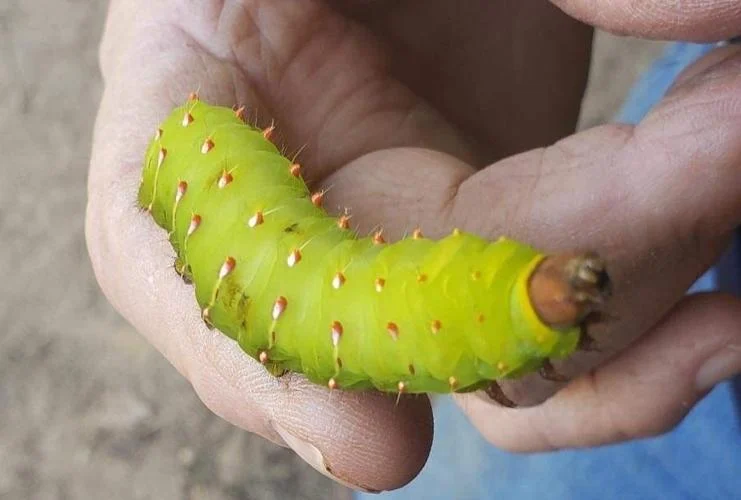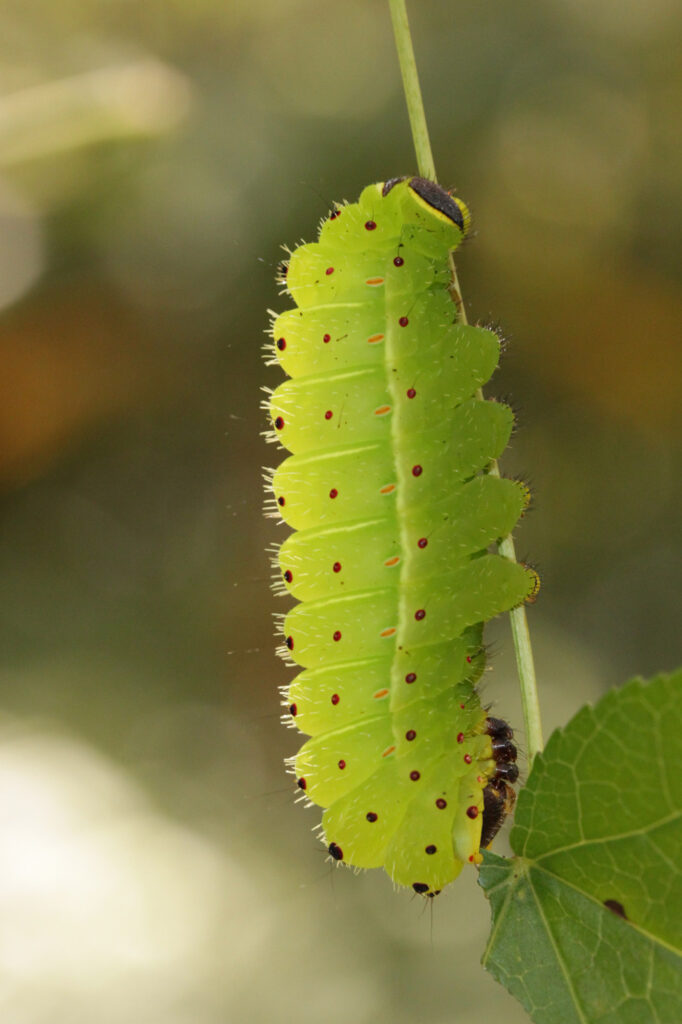Luna moth caterpillars, also known as Actias luna, have specific dietary preferences. They primarily feed on the leaves of deciduous trees, particularly those from the following tree families:
- Birch (Betulaceae): Luna moth caterpillars are often found feeding on birch tree leaves.
- Walnut (Juglandaceae): They may also consume leaves from walnut trees.
- Hickory (Juglandaceae): Hickory tree leaves are another common food source for Luna moth caterpillars.
- Sweetgum (Altingiaceae): In some regions, sweetgum tree leaves are also on their menu.
- Paper Birch (Betula papyrifera): This particular birch species is a favored food source for Luna moth caterpillars.
How do Luna moth caterpillars become adult moths?

Luna moth caterpillars undergo a remarkable transformation as they develop into adult moths through a process known as metamorphosis.
Description of Luna Moth Caterpillars
Physical Appearance: Luna moth caterpillars are easily recognizable due to their distinctive appearance.
They have a bright green body covered in fine, soft hairs, giving them a velvety texture. Their body is segmented, and they typically measure around 2.5 to 3 inches in length.
Luna moth caterpillars have five pairs of prolegs (suction-cup-like appendages) on their abdomen, in addition to three pairs of true legs on their thorax. The head capsule is usually yellow-green or brown, and they have a pair of prominent, horn-like structures called “scoli” on their first and second thoracic segments.
Lifecycle Stages: Luna moth caterpillars undergo a series of developmental stages before transforming into adults.
Egg Stage: It all begins when a Luna moth female lays small, spherical, pale-green eggs on the underside of leaves.
Caterpillar Stage: After hatching from the eggs, they enter the caterpillar stage. During this phase, they feed voraciously on leaves and grow in size. The caterpillar stage is further divided into instars, with caterpillars molting and shedding their exoskeleton several times as they grow.
Pupa Stage: Once they reach a sufficient size and maturity, Luna moth caterpillars spin a silk cocoon and undergo metamorphosis within it. At this point, they enter the pupal stage, during which they transform into adult moths.
Adult Stage: After a period of time in the pupal stage, adult Luna moths emerge from their cocoons. These moths have a characteristic pale green color, long tails on their hindwings, and a wingspan of about 4.5 to 5 inches.
Overview of Metamorphosis
Transformation into Adult Luna Moths: The metamorphosis of Luna moths from caterpillars to adults is a remarkable process. Inside the silk cocoon, the caterpillar undergoes a complete transformation. Its body undergoes significant changes in structure and function.
The caterpillar essentially dissolves into a soup-like substance within the cocoon, and its tissues and organs are reorganized to form the adult moth.
During this process, the caterpillar’s body undergoes a profound reconfiguration, and its mouthparts, which were adapted for chewing leaves as a caterpillar, are transformed into a proboscis suitable for sipping nectar as an adult.
Moreover, the transformation into an adult Luna moth is a delicate and intricate process that takes several weeks to complete.
Once the transformation is complete, the adult moth emerges from the cocoon, and it is now ready to begin its brief but important adult stage, which is primarily focused on reproduction.
What are the primary food sources of Luna moth caterpillars?
Luna moth caterpillars primarily rely on a specific diet consisting of the leaves of certain tree species, with a preference for plants like the sweet gum, birch, and persimmon.
Primary Food Sources
Birch Trees (Betulaceae)
Importance of Birch Leaves:
- Birch leaves are a staple food source for Luna moth caterpillars.
- Birch leaves are rich in nutrients, particularly in proteins and carbohydrates, which are essential for the caterpillar’s growth and development.
- The tender nature of birch leaves makes them easily digestible for the caterpillars, and they provide the necessary sustenance for their rapid growth during the larval stage.
Walnut Trees (Juglandaceae)
Nutritional Value of Walnut Leaves:
- Luna moth caterpillars are known to feed on the leaves of various walnut tree species.
- Walnut leaves are a valuable food source due to their high protein content, which supports the caterpillar’s growth.
- These leaves also contain essential minerals and vitamins that contribute to the caterpillar’s overall health and development.
Hickory Trees (Juglandaceae)
Specific Hickory Tree Species:
Some Luna moth caterpillars are known to favor specific hickory tree species within the Juglandaceae family. Hickory leaves provide a suitable diet due to their nutritional content, including proteins, fats, and carbohydrates.
Different hickory species may vary in their leaf composition, but caterpillars adapt to their local environment by feeding on available hickory leaves.
Sweetgum Trees (Altingiaceae)
Regional Variations in Diet:
In certain regions, Luna moth caterpillars may also consume sweetgum tree leaves.
Sweetgum leaves, like the other preferred trees, provide essential nutrients, enabling caterpillars to thrive in areas where these trees are prevalent.
Regional variations in diet can occur based on the availability of these tree species.
Selective Eating Habits
Why Luna Moth Caterpillars Focus on Specific Trees:
Luna moth caterpillars exhibit selective eating habits primarily because they have evolved to specialize in utilizing the leaves of specific tree species. This specialization is an adaptation that ensures caterpillars have access to suitable and nutritious food sources for their development.
By focusing on particular trees, Luna moth caterpillars can efficiently obtain the required nutrients and minimize the risk of consuming unsuitable or toxic plant materials.
Avoidance of Other Plant Types
Explanation for Their Limited Diet:
Luna moth caterpillars avoid consuming other plant types as a survival strategy. Their limited diet helps reduce the risk of ingesting toxins or substances that might be harmful to them.
Specializing in certain tree species allows them to develop physiological adaptations for efficiently processing the specific nutrients present in those leaves.
How does Luna moth caterpillar diet impact their transformation?

The Luna moth caterpillar’s diet plays a crucial role in its transformation, as the nutrients and chemicals from specific leaves not only sustain its growth but also influence its physical characteristics and development into a stunning adult moth.
Consumption Patterns
Amount of Leaves Consumed: Luna moth caterpillars are voracious eaters, and they consume a significant amount of leaves during their caterpillar stage.
The amount of leaves they eat varies depending on their developmental stage and individual size. Younger caterpillars consume less than older, larger ones.
As they grow, they molt and shed their exoskeleton, which allows them to accommodate their increasing size and appetite. They can consume a substantial portion of a tree’s foliage, but their feeding usually does not harm mature, healthy trees. However, heavy infestations in young or stressed trees can cause damage.
Frequency of Feeding:
- Luna moth caterpillars feed frequently, often daily.
- Their feeding activity is concentrated during the night and early morning hours when they are less exposed to predators.
- During daylight hours, they typically rest on the undersides of leaves or branches, camouflaging themselves to avoid detection.
Role of Leaves in Caterpillar Growth
Nutritional Requirements: The leaves of the specific tree species preferred by Luna moth caterpillars provide essential nutrients crucial for their growth.
Moreover, these nutrients include proteins, carbohydrates, fats, vitamins, and minerals, all of which are necessary for their development. Protein, in particular, is essential for building and repairing tissues, making it a vital component of their diet.
Supporting Development: The leaves not only supply necessary nutrients but also provide water to caterpillars, helping maintain their hydration.
Furthermore, the continuous consumption of leaves allows the caterpillars to grow rapidly and reach the required size for pupation.
Leaves also play a role in the development of the caterpillar’s silk-producing glands, which are crucial for cocoon construction during the pupal stage.
Importance of Their Diet for Metamorphosis
The diet of Luna moth caterpillars has a direct impact on their ability to pupate and eventually transform into adult moths. Caterpillars must attain a sufficient size and store enough energy through their diet to successfully pupate.
During the pupal stage, which occurs within a silk cocoon, the caterpillar’s body undergoes a remarkable transformation, and it relies on the energy and nutrients accumulated during its caterpillar phase to fuel this process.
The metamorphosis from caterpillar to adult is highly energy-intensive, and a healthy diet is critical for the development of the adult moth’s reproductive organs and overall vitality.
FAQ’s
How long do Luna moth caterpillars eat?
Luna moth caterpillars typically feed for several weeks, with the exact duration depending on environmental conditions and the availability of food.
Where do you put Luna moth caterpillars?
Luna moth caterpillars are usually found on the leaves of their preferred host trees, such as birch, walnut, hickory, or sweetgum.
Are Luna moths prey?
Yes, Luna moths are prey to various predators, including birds, bats, and other nocturnal animals.
Are Luna moths good luck?
In some cultures, Luna moths are considered symbols of good luck, representing positive transformation and spiritual growth.
Can you raise Luna moth caterpillars?
Yes, it is possible to raise Luna moth caterpillars in captivity, provided you can provide them with their preferred host plants and conditions conducive to their development.
How long do Luna moths live?
Luna moths typically have a short adult lifespan, living only for about one to two weeks after emerging from their cocoon.
Final Words
In conclusion, Luna moth caterpillars exhibit a highly specialized and selective feeding behavior that is intricately tied to their growth, development, and successful metamorphosis into adult moths. Their preference for specific tree species, such as birch, walnut, hickory, and sweetgum, is not arbitrary but driven by nutritional requirements and survival strategies.
The leaves of these trees provide the necessary nutrients, including proteins, carbohydrates, and minerals, enabling these caterpillars to thrive and grow rapidly.
Their feeding patterns, characterized by voracious consumption of leaves during the night and resting during the day, support their energetic demands.
Moreover, this diet serves as a crucial preparatory phase for the metamorphosis process, providing the energy and nutrients needed for pupation and the development of adult Luna moths.

